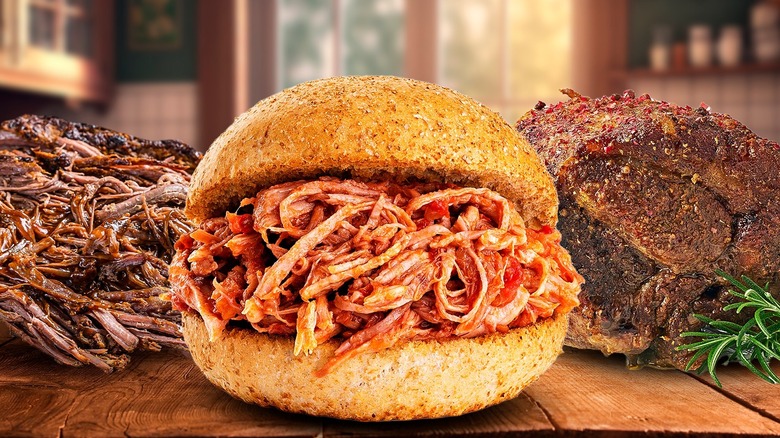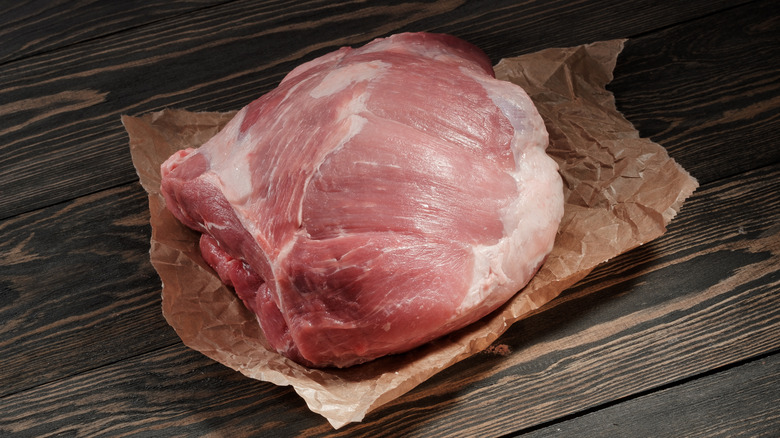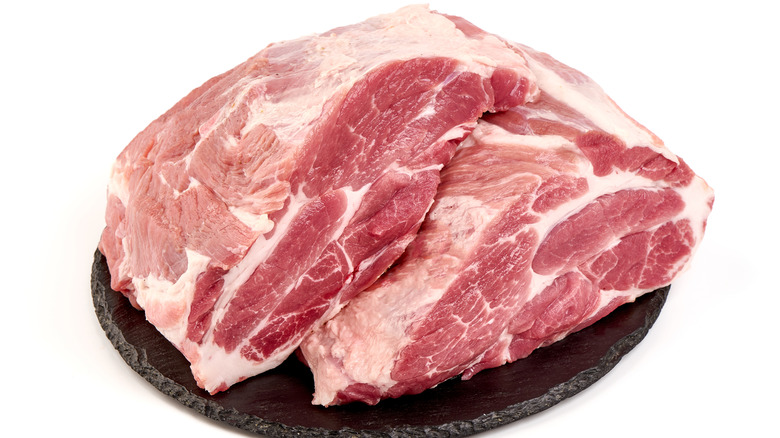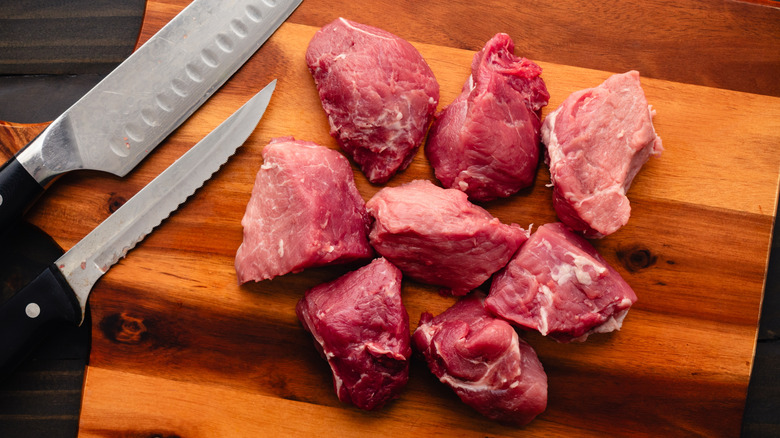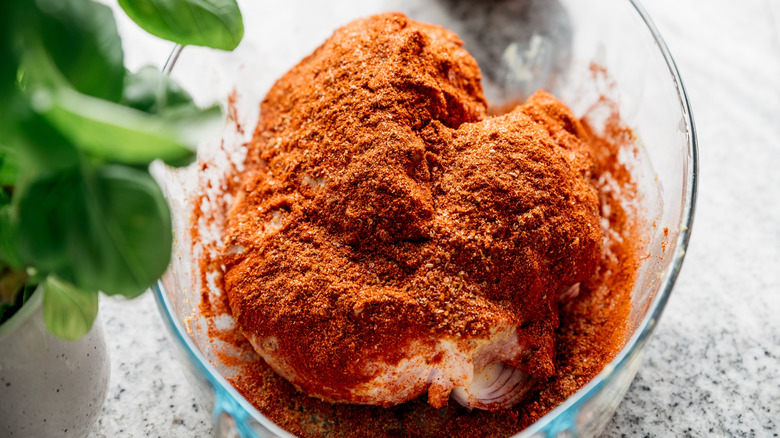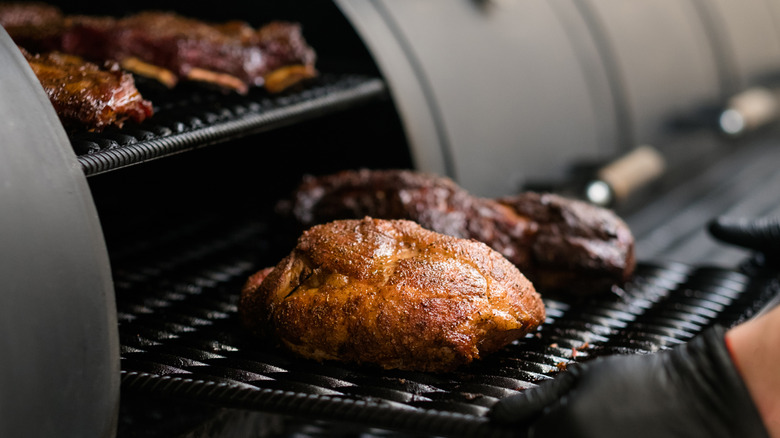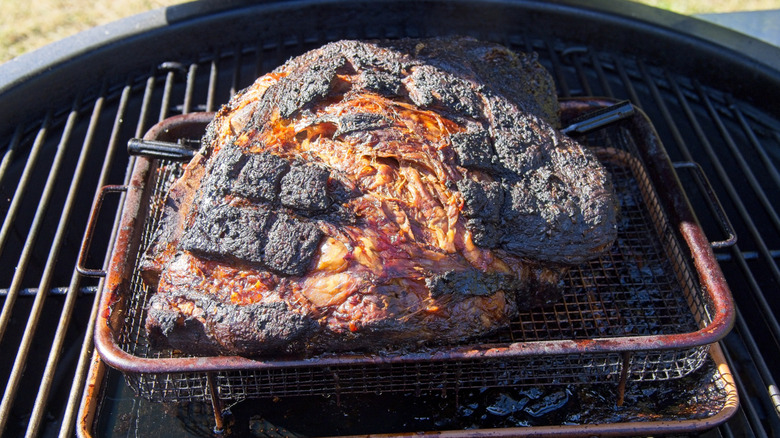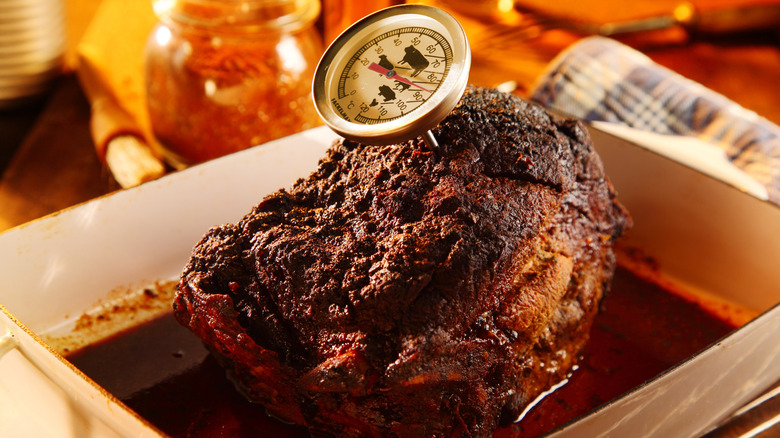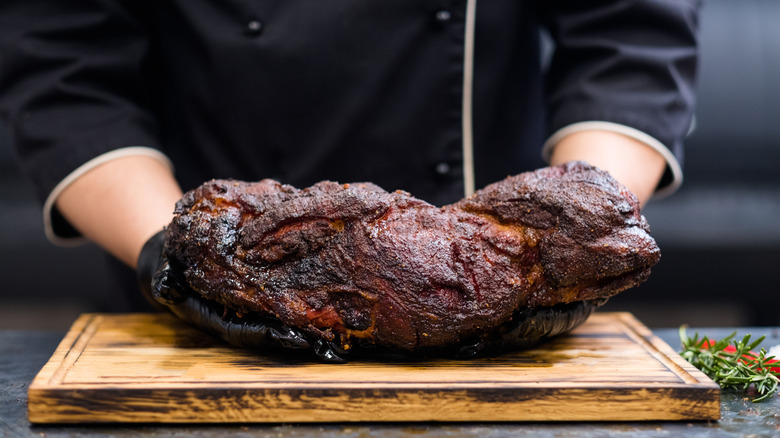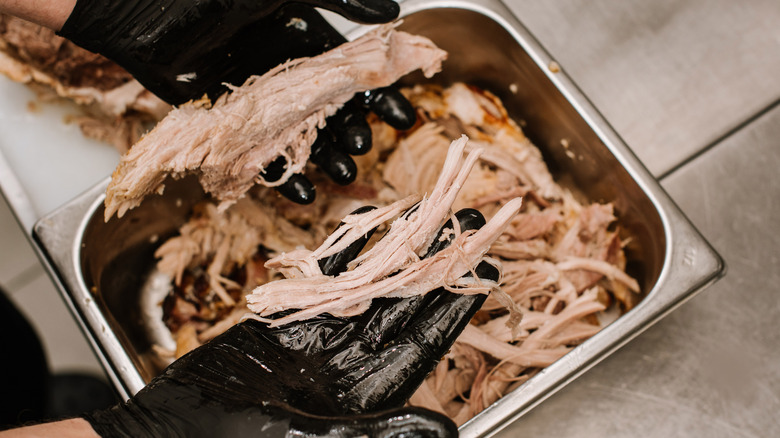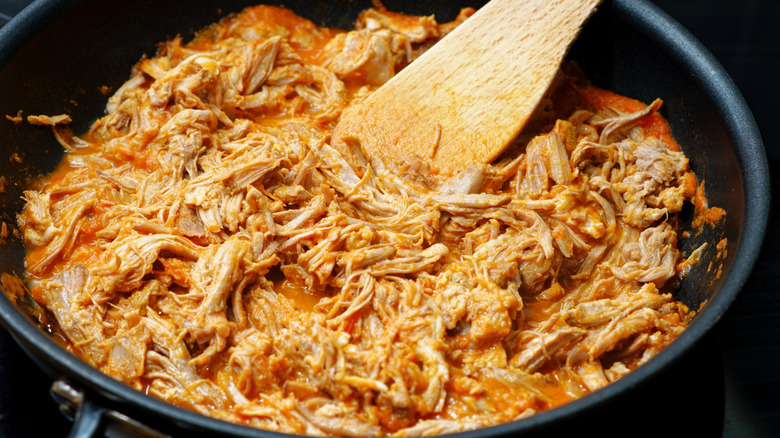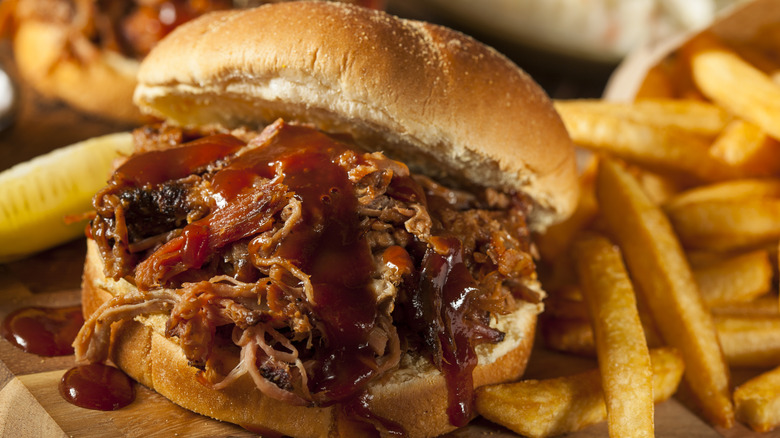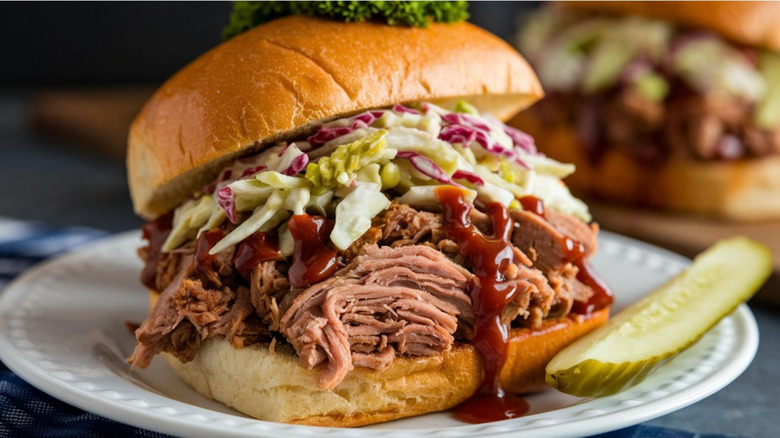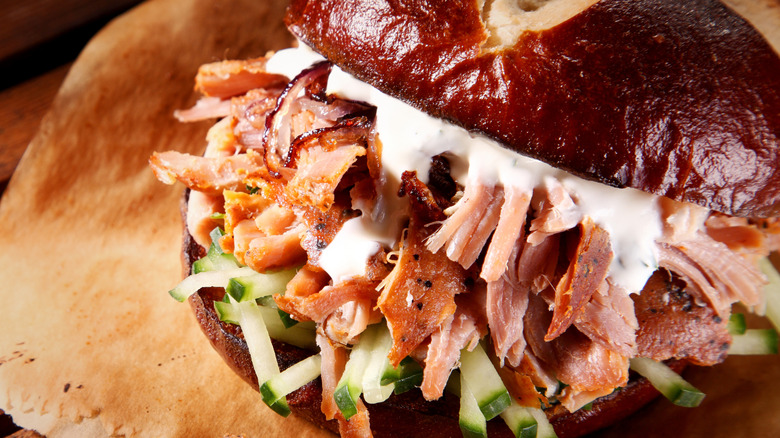13 Tips For Perfecting The Pulled Pork Sandwich
The pulled pork sandwich is a barbecue classic that's so simple, yet so satisfying. All you need is succulent shredded pork piled between two pieces of bread or a fluffy bun. Add a splash of barbecue sauce and some coleslaw or pickles and you have the perfect handheld meal. Yet, despite being a relatively straightforward dish, it can be tricky to get every element of the sandwich just right. Ideally, you want the meat to be juicy and well seasoned, the bread to be supple, and the toppings and condiments to complement the pork without detracting from its flavor. That's where experts can help.
In our quest to concoct the perfect pulled pork sandwich, we spoke to renowned pitmasters, barbecue experts, and chefs who specialize in this Southern dish. We picked their brains about everything from how to prepare the pork to proper cooking methods, the best bread to use, and essential toppings. They gave us some stellar advice on creating pulled pork sandwiches that wouldn't be out of place at a world-renowned barbecue joint. Whether you're an amateur griller or a barbecue pro, these tips can help you take your pulled pork sandwiches to the next level.
1. The right pork cut makes all the difference
Pitmasters may vary in their techniques for achieving amazing pulled pork, but if there's one thing they all agree on, it's that only one cut of pork will give you tender, juicy meat. Every expert we spoke to said they use pork butt, aka Boston butt. This large cut comes from the shoulder area of the pig, and it can come with or without the bone. It has plenty of marbling, which is what you want for meats that are cooked low and slow like pulled pork. You can also use the pork shoulder, but many experts say pork butt is far superior.
There are a few reasons the experts only use pork butt for their pulled pork. David Figueroa, president and co-founder of Melinda's Foods, said, "Pork butt has the perfect balance of fat and flavor, making it ideal for pulled pork. As it cooks low and slow, the fat and connective tissue break down beautifully, leaving you with juicy, tender meat every time." In addition, pork butt is typically a large cut that gives you plenty of surface area to develop bark. The uniform, rectangular shape also helps the meat cook evenly.
2. Fat can be your secret weapon
Most pork butts you find will have a fat cap attached to one side of the meat. You may be tempted to cut that part off. After all, the idea of eating pure fat can be rather unappealing. Plus, pork butt already has tons of fat marbled throughout the meat, so why add extra fat to the mix? Well, that's where you might be doing your pulled pork a great disservice.
Barrett Black is a fourth-generation pitmaster at The Original Black's Barbecue in Texas and a huge proponent of keeping the fat cap on. He told us, "Fat is essential for keeping the meat juicy and flavorful as it renders down during the cook. Instead of removing it, let the fat work its magic, and mix it back into the meat after cooking for added richness." Some people score the fat cap to help it render better and to allow more seasoning to penetrate the meat. Others trim the fat cap down to about a ¼ inch so that it still imparts moisture and flavor but also allows more space for the bark to form.
3. Consider cutting your meat into smaller chunks
For many people, there's something absolutely magical about opening up a grill or smoker and seeing a huge hunk of meat cooked to perfection. But what do you do if you don't have the space to cook a whole Boston butt in its entirety? While some might say it's sacrilege to cut your pork butt into pieces before cooking it for pulled pork, others say there are actually some benefits to using smaller chunks.
Barrett Black told us that the pitmasters at The Original Black's Barbecue often cut the meat into chunks about the size of softballs before cooking it. He said, "This increases the surface area for bark development, which is where you get that deep, smoky, salty crust — arguably the best part of any smoked meat." In addition, he explained that it's quicker to cook smaller pieces of pork, which is great if you're strapped for time. Cutting the pork also makes sense if you're using a slow cooker or want to braise your pork in the oven but don't have an extra large pot.
4. Season before and after cooking
Any barbecue expert will tell you that seasoning is crucial for any type of meat that's going in the smoker or on the grill. Pork butt is no exception. Many chefs prefer dry rub for pulled pork because pork butt is such a large cut that it can be tricky to submerge it completely in a marinade. Plus, the dry rub helps to create a nice crust on the exterior of the meat. If you really want to enhance the flavor of your pulled pork, many experts recommend seasoning the meat before and after cooking.
Christie Vanover, champion pitmaster and founder of Girls Can Grill, said, "For the best results, season your pork shoulder liberally with dry rub before cooking it. Then, once it's fully cooked and time to shred, sprinkle on more of the same dry rub to enhance the flavors even more." Vanover uses a special rub she created specifically for pulled pork that's sweet and has savory elements like garlic, onion, and chiles. Other spices that people use for pulled pork dry rub include paprika, cumin, and mustard powder.
5. Smoke your meat if you can
There are several ways you can cook pulled pork at home including in the oven, slow cooker, or grill. However, many experts believe smoking is the best way to go. Pitmaster Shannon Snell of Sonny's BBQ said, "Pork has to get to a high enough temperature for the intramuscular fibers to break down and for the collagen to become gelatin (around 195 to 200 degrees [Fahrenheit]). Smoking allows you to do this as smokers can get up to 600 degrees [Fahrenheit]." In addition, smoke adds extra flavor to the meat.
If you don't have a smoker, there's an easy hack for turning your grill into a smoker. Just wrap some presoaked wood chips in tin foil and cut a few small holes in the foil. Then, place the wood chip packet close to the heat source on your grill so that the chips smolder but don't burn. As for the best type of wood for smoking, pitmasters have different preferences. For example, Carey Bringle, founder of Peg Leg Porker, uses hickory, while Barrett Black opts for local post oak wood. You can also try cherry, apple, or pecan wood.
6. Patience is the key to perfect pulled pork
One of the biggest mistakes that people make with pulled pork is trying to rush the process. Any pitmaster will tell you that patience is the key to getting the perfect texture and taste. As Barrett Black explained, "Pulled pork needs low and slow cooking to allow the connective tissues to fully break down, making the meat tender enough to shred. If the pork isn't tender enough to pull apart with just your hands, it needs more time on the smoker."
If you're cooking your pork on the grill or in a smoker, many of the experts we spoke to recommend getting the heat to between 220 and 250 degrees Fahrenheit. Anything higher than that and you risk drying out the meat and making it tough. Cooking times will vary depending on the size of your pork butt, but David Figueroa recommends cooking it for at least five hours and up to eight hours. If you're braising your meat in the oven, Christie Vanover recommends setting the oven to 375 degrees Fahrenheit and cooking your pork in a covered pot with braising liquid until it's tender and falling apart. If the meat isn't easily shreddable, it needs more time.
7. Keep an eye on the internal temperature
Cooking a big cut of meat like pork butt can be tricky because it's hard to tell when the meat is fully cooked just by glancing at it. Your pork may have beautiful bark on the outside and feel soft to the touch, but you want to make sure that the interior is cooked enough so that it's safe to eat, but also juicy and tender. A meat thermometer is crucial for letting you know when the pork is at the perfect internal temperature.
Carey Bringle said, "People often overcook or undercook the pork. You're shooting for an internal temperature of 192 to 200 degrees [Fahrenheit]. Stay in that range and you will be great." Some pitmasters recommend wrapping the pork in tin foil when it gets to 150 degrees Fahrenheit to protect it from the heat and smoke, and to help keep the juices in. As the wrapped pork cooks, you'll need to keep checking on it. When it hits the 190 degree Fahrenheit mark, that's when you want to pull it off the heat. The highest internal temperature the pork should reach is 205 degrees Fahrenheit.
8. Let the pork rest before shredding it
Once your pork hits that sweet 190 degree Fahrenheit mark and you've pulled it off the heat, it can be tempting to start shredding it right away. However, experts will tell you that it's a huge mistake to cut into meat right off the grill. Meat needs to rest after coming off the heat so that the muscle fibers loosen up and the juices can redistribute throughout the meat. If you cut into your pork right away, you'll likely end up with dry, stringy pork that lacks the richness that you want.
Shannon Snell told us, "The doneness temperature of pulled pork ranges from 195 to 205 degrees [Fahrenheit]. During that process of high temperature, the pores of the meat are wide open, allowing a lot of the juices to escape. Resting to 160 degrees [Fahrenheit] allows those pores to close back up, thus sealing in all the natural juices and making a much more moist final product." Many experts recommend letting the meat rest for at least 30 minutes and up to an hour after it comes off the heat.
9. Hand shredding will give you the best results
The most laborious part of making pulled pork is the shredding process. You could go the easy route and chop it or use forks or meat claws to pull it apart. For Christie Vanover though, the old-fashioned way is ideal. She said, "When pulling pork, there are different shredding tools you can use, but you'll get the best results if you use your hands." Using your hands allows you to pull out any pieces of fat that haven't rendered down and makes it easier to break up the bark.
Vanover recommends wearing a pair of cotton gloves and then a pair of nitrile gloves over those to protect your hands from the heat. If your pork butt has a bone in it, you'll want to pull that out first. Then, you can break up the meat and discard any big pieces of fat you come across. Work with the grain to pull the meat apart. Some people like to pull their meat into big chunks, while others prefer shredded strands of meat. You can also set the bark aside to eat on its own or break it up and mix it into the meat.
10. Hang on to that braising liquid
If you're cooking your pork in the oven or a slow cooker, you'll need to add some liquid to the pot to prevent the meat from drying out. Christie Vanover recommends butter, maple syrup, water, or broth. The liquid keeps the meat moist and can impart extra flavor. But that's not all the braising liquid can do. If you hang onto those juices, you can use them to revive meat that's a little on the dry side. You can also store the pork in the braising liquid so that when you reheat your pulled pork, it's still juicy and flavorful.
If you're cooking your pork on the grill or in a smoker, many pitmasters recommend using a pan to catch the juices that drip off the pork. Barrett Black said, "To elevate the flavor, we save the drippings during the cook and mix some of that back into the pulled pork — those drippings are liquid gold." You may want to filter out the fat from the drippings before incorporating it back into your meat. In addition, you can use the drippings to make a glaze or barbecue sauce that you can drizzle on your sandwich.
11. Soft and sturdy bread is the way to go
Most barbecue joints serve their pulled pork on simple soft white bread or a roll. According to many of the experts we spoke to, there's a reason for that. Carey Bringle said, "The best bun for a pulled pork sandwich is a white bread soft bun. You want it to be able to soak up some of the juices and BBQ sauce and don't want it too heavy. You want to highlight the pork, not the bun."
If you want to get a little more creative with your bread, several of the experts we spoke to recommended a brioche bun. Shannon Snell said, "There is a natural buttery sweetness in brioche bread that pairs well with pork." Christie Vanover also suggested Hawaiian rolls. Chef Ashley Lonsdale of ButcherBox prefers something a little sturdier. She said, "A pulled pork sandwich is delicious on something comforting and soft like a brioche roll, but I like to build it like an open-faced toast on a crusty slice of bread to contrast the tender pork."
12. Crunchy toppings add contrast
When it comes to toppings for pulled pork sandwiches, people usually fall into two camps: classic or creative. Some say coleslaw is the only way to go, while others have no problem playing around with different ingredients. However, most people agree that crunchy toppings work best with the soft pulled pork and fluffy bun. Ashley Lonsdale said, "Texture is a welcome component. Shredded cabbage, raw onion, carrot, or any sort of crispy or crunchy vegetables will add another dimension to the sandwich."
Some chefs believe that acidity is also key because it helps balance the fatty pork and any sweet elements you might add like barbecue sauce. Barrett Black told us, "Classic toppings like crunchy coleslaw and pickles are essential. The coleslaw adds a refreshing crunch and tang that cuts through the richness of the pork, while pickles bring a bright acidity to balance the flavors." Pickled red onions are also a great option because they add zest and pops of color. Pickled jalapeños can also add texture, tang, and a hit of heat.
13. Get creative with your condiments
Sauces are another area where people have strong opinions about what works best for a pulled pork sandwich. Part of the reason is because there are so many regional barbecue sauces across the United States. For example, folks from Kansas City might prefer a sweet barbecue sauce, while people from Eastern North Carolina are all about tangy vinegar-based sauces. In Memphis, you might find tomato-based sauces made with vinegar, sugar, and mustard. With that in mind, you shouldn't be afraid to get creative with your condiments.
Christie Vanover recommends playing around with different flavor profiles to create unique sandwiches. For example, she suggested amping up your coleslaw with unique ingredients like julienned green apples or grilled pineapple chunks. She said, "Pork marries well with Asian and Latin flavors too. Toss pulled pork with Japanese barbecue sauce and load it into a bao bun with pickled vegetables. Or make chile verde by mixing pulled pork with green chile sauce. Pile it onto tortillas with diced onions and cilantro." At the end of the day, it's your sandwich and you can dress it any way you like.
